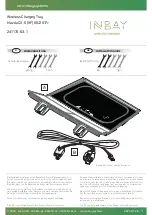
10
EN
4.4 Advanced options
4.4.1 Programmable Alarm relay
The Inverter Charger Combi is equipped with one or two (depending
on model) programmable potential free alarm relays. Standard, this
relay (or relay 1 on ICC 3000 SI-N/120A model) will be activated when
the unit shuts down and jumps to an error mode. The alarm relay
de-activates again when the error has been resolved and the Inverter
Charger Combi is running in normal operating mode again.
Relay 2 on the ICC 3000 SI-N/120A model will be activated only after
the AC supply has become available. In case of battery operation, Relay
2 will deactivate immediately. This can be used to switch less critical
AC loads (i.e. electric boiler, aircon) on and off that are allowed to be
supplied by the mains or generator only.
Using Dashboard software, it is also possible to configure the pro-
grammable relays to perform a different task, like starting a generator
when the battery voltage has reached a certain low voltage level.
Both normally closed and normally open contacts of these relays are
available. For the ICC 1600 SI-N/60A model, the maximum relay contact
ratings are 30VDC/1A or 60VDC/0.3A. For the ICC 3000 SI-N/120A model,
the maximum relay contact ratings are 30Vdc/16A or 250Vac/16A.
4.4.2 Trigger input
The trigger input offers a way of externally controlling the behaviour
of the Inverter Charger Combi. The trigger input can be connected to
an external switch or a potential free relay contact. By closing this
external switch or contact, a user programmable “action” will be
performed. Such an action could for example be to release the
AC transfer switch, temporarily disable the AC input Power Boost
feature or force the Inverter Charger Combi to switch to inverter mode.
All this can be configured. The ICC 1600 model is equipped with one
trigger input, while the ICC 3000 models is equipped with two trigger
inputs.
4.5 Load requirements in inverter mode
Before you connect your appliance(s) to the Inverter Charger Combi AC
output, always check it’s maximum power consumption. Do not
connect appliances to the AC output requiring more than the nominal
power rating of the inverter continuously. Unless these appliances are
switched on only when the AC transfer switch is activated, and power
is drawn from an external source with a larger capacity than the inverter.
Some appliances like motors or pumps, draw large inrush currents at
startup. It is possible that the startup current exceeds the overcurrent
trip level of the inverter. In this case the output voltage will shortly
decrease to limit the output current of the inverter. If the overcurrent
trip level is continuously exceeded, the inverter will shut down and
automatically restart within 20 seconds. In this case it is advisable to
disconnect this appliance from the inverter, since it requires too much
power to be driven by this unit. The Inverter Charger Combi needs to
be restarted manually when it has shut down due to overloads for four
times in a row. Note that at higher ambient temperature levels, the
overload capacity of the Inverter Charger Combi will be reduced.
5. Charger operation
5.1 Charge programs
All standard selectable charge programs (using DIP switches 4, 5 and 6),
perform a four stage IUoUoP charging process comprising of a “Bulk”,
an “Absorption”, a “Float” and a “Pulse” stage. The image below
visualizes the four stage charging process:
In the Bulk stage, the charger delivers full output current and typically
returns approximately 80 % of charge back into the battery once the
absorption voltage is reached. During this stage, the battery empty
and battery 50 % full indicators will be lit depending on the Bulk
charge progress. When the absorption voltage has been reached, the
Absorption stage will be entered and the battery 80 % full indicator
will be lit. This stage will return the final 20 % of charge to the battery.
The output voltage is kept at a constant level and the charge current
decreases as a function of the battery’s state of charge. When the
charge current has dropped below a certain value or when the
maximum absorption timer has been expired, the Float stage will be
entered. The battery full Indicator will be lit and an acoustical message
will sound, indicating that the battery is full. In this stage the battery
voltage will be held constant at a safe level for the battery. It will
maintain the battery in optimal condition for as long as the battery
remains connected to the activated charger. Connected battery loads
will be directly powered by the charger up to the charger’s maximum
output current level. When even more current is drawn, the battery
must supply this which results in a declining battery voltage. At a
certain battery voltage level, the charger jumps back to the Bulk stage
and will finalize a complete charging process again, once the battery
load consumption has dropped below the charger’s maximum output
current level.
The fourth stage called “Pulse”, will perform a short refresh charge of
approximately 1 hour each 7 days while the charger operates in the
Float stage.
Summary of Contents for MT 81660
Page 2: ...2 EN 3 19 35 Content Inhalt Contenu EN DE FR...
Page 51: ......











































